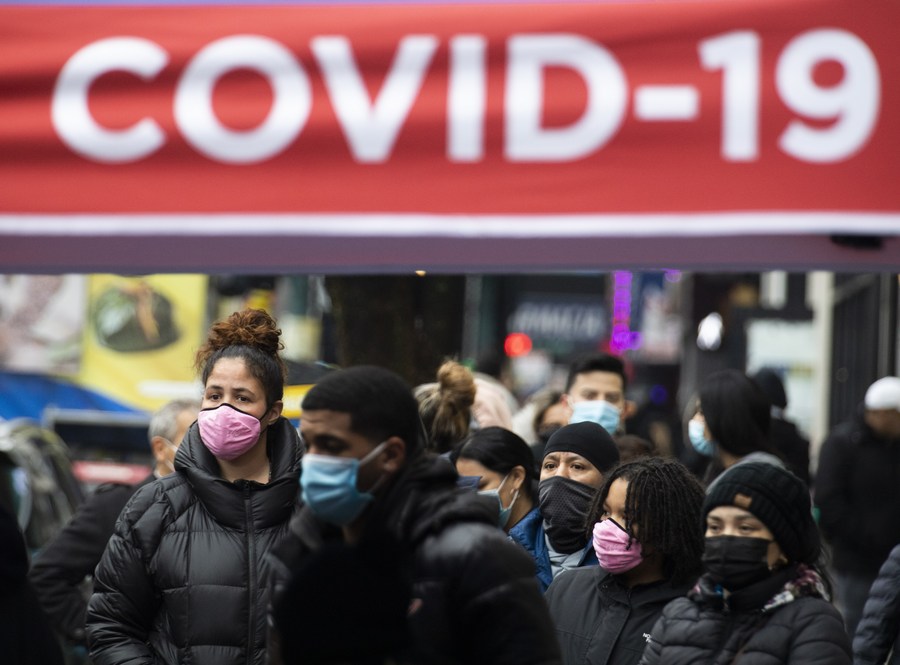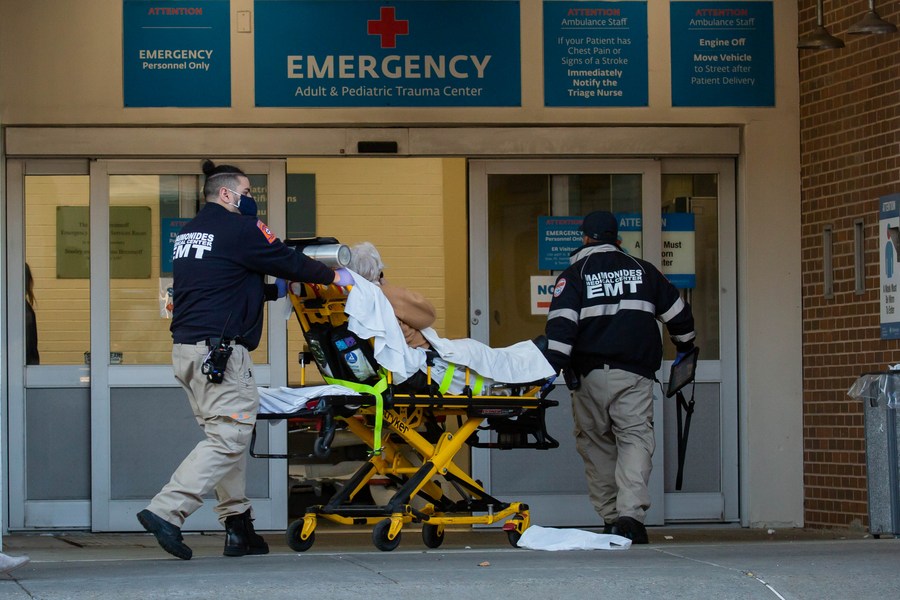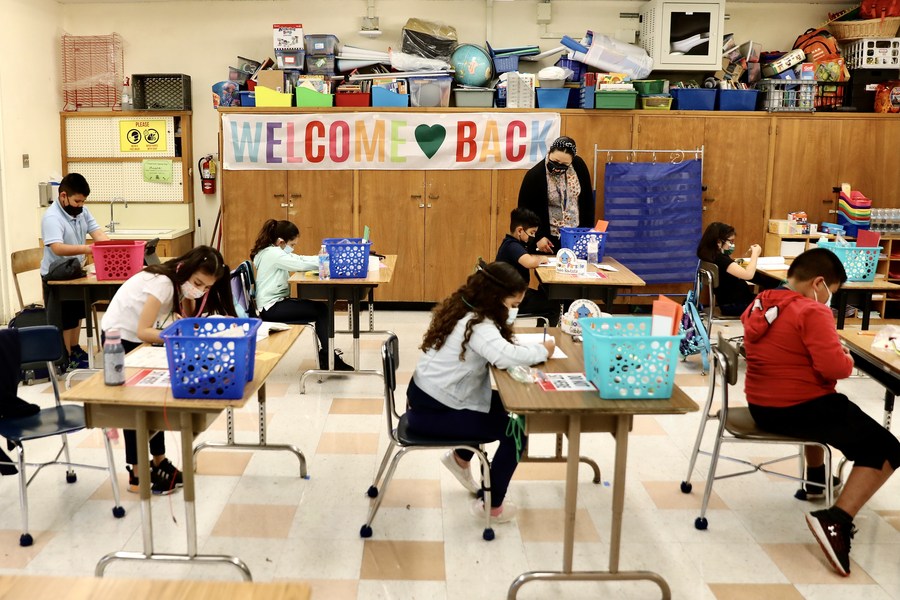
People wait for COVID-19 testing in the Queens borough of New York, the United States, Dec. 29, 2021. (Xinhua/Wang Ying)
On Monday, the United States shattered a single-day record with over 1 million COVID-19 cases amid the rapid spread of the Omicron variant and government decisions to ease prevention and control measures in the country. More than 103,000 Americans were hospitalized with COVID-19, the highest number since late summer.
NEW YORK, Jan. 4 (Xinhua) -- As the United States sees new records of COVID-19 cases and hospitalizations with the surge of the Omicron variant of COVID-19, large parts of the country are increasingly intimidated by the virus and schools are caught in a predicament.
ALARMING FIGURES
More than 103,000 Americans were hospitalized with COVID-19 on Monday, according to official data, the highest number since late summer when the Delta variant of the coronavirus triggered a nationwide surge in cases.
The figure reflected the 27 percent rise in COVID-19 hospitalizations in the United States in the past week. Average daily new deaths from COVID-19 declined by 8 percent.
Hospitalization numbers better capture the pandemic's impact than infection figures, Anthony Fauci, the U.S. president's chief medical adviser, told ABC's "This Week" on Sunday. The worst day of the pandemic for hospitalizations was Jan. 14, 2021, with more than 142,000.

Medical workers wheel a patient into Maimonides Medical Center in the Brooklyn borough of New York, the United States, Dec. 14, 2021. (Photo by Michael Nagle/Xinhua)
Also on Monday, the United States shattered a single-day record with over 1 million COVID-19 cases amid the rapid spread of the Omicron variant and government decisions to ease prevention and control measures in the country. As of 0500 GMT Tuesday, the country registered about 1.07 million confirmed cases in the past 24 hours, according to Johns Hopkins University.
The Wall Street Journal reported that "the U.S. reported a record 1.08 million COVID-19 infections on Monday as most states worked to clear backlogs after pausing during the New Year's holiday." The new record pushed the seven-day average of daily reported infections to 480,273, nearly double the peak reached at the height of last winter's case surge.
So far, the United States has remained the country worst hit by the pandemic, with the world's most cases and deaths.
SOUTHERN SURGE
The United States is heading into the third year of the coronavirus pandemic with the extremely contagious Omicron variant poised to ignite a firestorm of infection across the Southeast after exploding through the Northeast and Mid-Atlantic regions, reported The Washington Post on Tuesday.
"Lower vaccination rates and fewer mask and vaccine mandates have created a much different environment for the Omicron variant to spread in the South, leaving experts unsure whether outbreaks will end up deadlier than in the North," said the report.

Shoppers purchase clothes at a shopping mall in Miami-Dade County, Florida, the United States, Nov. 26, 2021. (Photo by Monica McGivern/Xinhua)
Florida, Georgia, Louisiana and Mississippi are among the states experiencing the sharpest increases in COVID-19 hospitalizations since Christmas, and "the situation may only get worse, as initial outbreaks in metropolitan areas spread to more poorly vaccinated rural regions," it said.
Georgia has shattered records, with nearly 1 in 3 tests coming back positive in the last week of December, and in metro Atlanta, nearly half of tests were positive. New daily infections in Florida have hit an average of about 43,000, far above the peak of 23,000 reached during the Delta variant surge in the summer.
In the meantime, Louisiana also has surpassed daily infection records set during its summer surge, with 12,500 cases reported on Thursday, which state officials said was nearly twice the record established in August.
David Rubin, who monitors coronavirus trends nationally for PolicyLab at Children's Hospital of Philadelphia, said he expects the Southeast to be a major driver of the nation's cases this month. "We are going to continue to have waves in the new year that I think will become lesser in amplitude over time," said Rubin.
SCHOOL REOPENING
Amid the pandemic surge, the first physical CES electronics show in two years will kick off this week in Las Vegas, though organizers have shortened the tech event by a day, and several major companies have pulled out.
Meanwhile, the Food and Drug Administration on Monday authorized booster shots of the Pfizer-BioNTech coronavirus vaccine for 12-to-15-year-olds, and shortened to five months the time required between the second dose of the vaccine and a booster.

Students attend an in-person class in a school in Los Angeles, California, the United States, on April 13, 2021. (Xinhua)
Amid the booster stimulus, a majority of schools across the country are reopening for in-person learning this week despite the Omicron surge, mindful of the academic, logistical and social-emotional disruptions that remote education inflicted last year and determined to avoid a repeat.
However, "the Omicron surge threatens to upend any sense of peace in the nation's education system," reported The New York Times on Tuesday, adding that after a holiday break that saw COVID-19 cases spike unrelentingly, a small but growing list of districts moved temporarily to remote learning for more than 450,000 children.
"Districtwide closures, even those that last for a week or two, are a step backward after months in which classrooms largely remained open," said the report. There were growing fears from parents and educators that more districts would soon turn to remote learning, even though in-school transmission of COVID-19 has been limited.
Official data last week showed that pediatric hospital admissions had reached a record high in the United States. The hospitalizations are primarily among unvaccinated people -- cumulative hospitalization rates through November are about 10 times higher for unvaccinated children ages 12 to 17. ■











